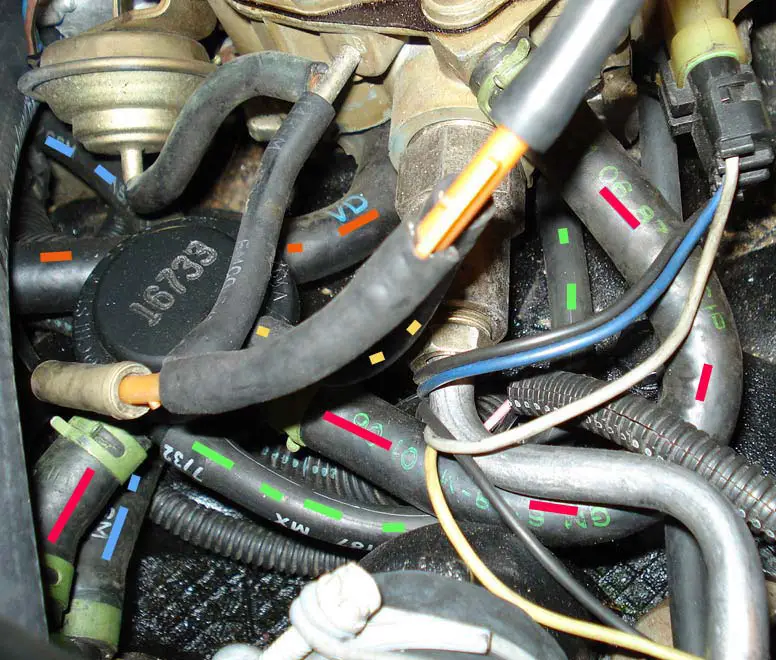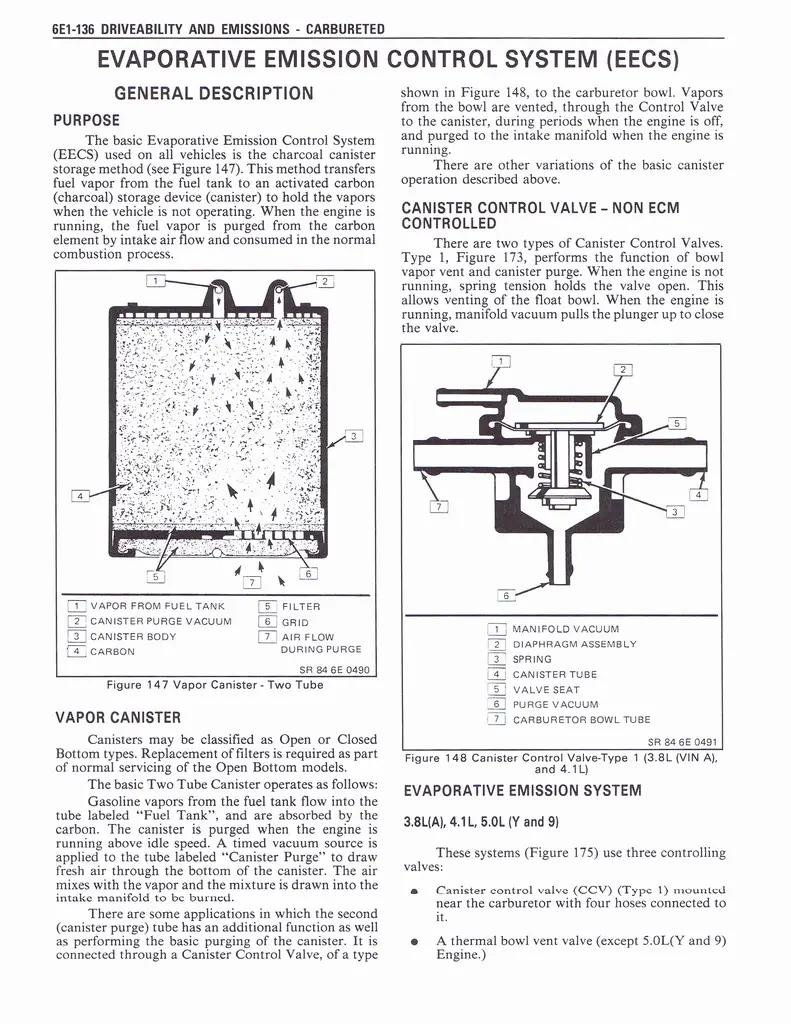Since I just rebuilt my carbon canister, today's Part of the Moment, or POM, is going to be the Canister Control Valve. On 307s, this valve was located on the front passenger side of the engine. Buried in there right in front of the carburetor corner. There's no bracket holding it down, as it doesn't need one. It's got spaghetti holding it in place. It's a plastic body, with rubber diaphragm valves and it operates on vacuum, or lack thereof. While these have been known to fail, it takes a good long time for that to happen. Usually the diaphragms get a hole in them and that's normally the cause of failure. PITA to change out if you've never done one before, but it's kinda important that it works properly.
Canister Control Valve (CCV). GM p/n 17085929. For 307 applications. Most of the time it's simply logistical tubing placement that makes a difference. Most all valves work about the same way. Not all, but most. Tomco and BWD and others have made and sold this valve over the years. So there shouldn't be any reason you couldn't find something to work on your car, GM or aftermarket.

Here's the top of the valve. It's about all you can see when it's stuck down in all that spaghetti on the intake. The ones in the lines, such as Chevy 305 applications, etc., the valves are usually in the line somewhere and a bit easier to get to. Notice too, that the ACDelco valves have a big ol' date stamp on the top as well. 20062 translates to the 200th day of 1986, or 1996, 2006, or 2016. 2nd shift. From the appearance of the baggie it came in, I'm going to guess
it's 1986. Which would be Saturday, July 19, 1986. They're still available from GM for a measly $62.60 list price as of this writing. Always check the valve diaphragm operation with a vacuum gage. It should hold manifold vacuum for minimum 20 seconds. You also should not be able to pass air from the biggest vent port to the other when vacuum is applied. This simulates it sitting on an operating engine, meaning the carb bowl vent should be closed off from the canister.
In effect, when the engine has been run, coolant is over the TVS open setpoint of 170 degrees F, and you shut the car down, the carb vent gets an open flowpath to the canister vent. During operation, you want the vent closed off because you don't want to impact the "air balance" in the bowl area which could affect fuel flow to the carb. CCC carbs are finicky about that sort of thing. You wouldn't think so, but... The only venting during operation is into the clean side of the air cleaner. Anyway, as soon as you turn the car off, you lose the vacuum holding the CCV valve closed, and since the car is warmed up fully, the carb vent can flow to the canister until the engine cools down and closes the TVS again.

Here's a better view of the ports. They're arranged this way on this particular part number due to the position on the engine and between the TVS and carb.

Here's one nestled into place on my 87 442. Trying to hide. Even though my car was super low on mileage when I got it, I changed piddly things on it that tend to fail over the years of not driving one. That's why it has a 16733 valve in it (made June 16 1993 or 2003). I didn't think to keep the old one. It still tested good, but at 20 years old when I got the car, it got replaced.


In the picture above-
The Blue dashed hose is coming from the charcoal canister to the TVS which is just outside the picture frame.
The Red dashed hose is going to the CCV (has 16733 stamped on top of it, #4), it also comes out of the bowl vent on top front of the carb (#7)and comes into the large port on the side of the CCV.
The Green dashed hose is coming from the CCV to the baseplate of the carb (#6). This is where the venting goes for the charcoal canister when the engine is running and TVS is open (>170 deg F). Carb vent side will be closed.
The Tan dashed line (#1) is coming from the air cleaner diverter valve "Y" to provide full time vacuum on the CCV to close the carb vent when the engine runs.
The Orange dashed line is your PCV line to the carb.

TVS- located in the water port JUST IN FRONT of the CCV on the 307s. Bottom port is coming FROM the canister. Top port connects to the CCV. At >170 deg F, the valve heats up and expands the valve against top spring pressure and opens to complete the "connection" between the canister and the engine. With the engine running and colder than 170 deg F, the valve will be closed and the only thing going on in the canister is the fuel tank venting to it. These things failed sometimes because the "glue" came loose from the little cap on top and pops it off because spring pressure is constantly on it. The little shuttle valve inside doesn't work anymore, and causes a huge azz vacuum leak and your car won't like it. Ask me how I know.

Here's what the 1984 Cutlass CSM has to say abou the system operation.



Canister Control Valve (CCV). GM p/n 17085929. For 307 applications. Most of the time it's simply logistical tubing placement that makes a difference. Most all valves work about the same way. Not all, but most. Tomco and BWD and others have made and sold this valve over the years. So there shouldn't be any reason you couldn't find something to work on your car, GM or aftermarket.

Here's the top of the valve. It's about all you can see when it's stuck down in all that spaghetti on the intake. The ones in the lines, such as Chevy 305 applications, etc., the valves are usually in the line somewhere and a bit easier to get to. Notice too, that the ACDelco valves have a big ol' date stamp on the top as well. 20062 translates to the 200th day of 1986, or 1996, 2006, or 2016. 2nd shift. From the appearance of the baggie it came in, I'm going to guess
it's 1986. Which would be Saturday, July 19, 1986. They're still available from GM for a measly $62.60 list price as of this writing. Always check the valve diaphragm operation with a vacuum gage. It should hold manifold vacuum for minimum 20 seconds. You also should not be able to pass air from the biggest vent port to the other when vacuum is applied. This simulates it sitting on an operating engine, meaning the carb bowl vent should be closed off from the canister.
In effect, when the engine has been run, coolant is over the TVS open setpoint of 170 degrees F, and you shut the car down, the carb vent gets an open flowpath to the canister vent. During operation, you want the vent closed off because you don't want to impact the "air balance" in the bowl area which could affect fuel flow to the carb. CCC carbs are finicky about that sort of thing. You wouldn't think so, but... The only venting during operation is into the clean side of the air cleaner. Anyway, as soon as you turn the car off, you lose the vacuum holding the CCV valve closed, and since the car is warmed up fully, the carb vent can flow to the canister until the engine cools down and closes the TVS again.

Here's a better view of the ports. They're arranged this way on this particular part number due to the position on the engine and between the TVS and carb.

Here's one nestled into place on my 87 442. Trying to hide. Even though my car was super low on mileage when I got it, I changed piddly things on it that tend to fail over the years of not driving one. That's why it has a 16733 valve in it (made June 16 1993 or 2003). I didn't think to keep the old one. It still tested good, but at 20 years old when I got the car, it got replaced.


In the picture above-
The Blue dashed hose is coming from the charcoal canister to the TVS which is just outside the picture frame.
The Red dashed hose is going to the CCV (has 16733 stamped on top of it, #4), it also comes out of the bowl vent on top front of the carb (#7)and comes into the large port on the side of the CCV.
The Green dashed hose is coming from the CCV to the baseplate of the carb (#6). This is where the venting goes for the charcoal canister when the engine is running and TVS is open (>170 deg F). Carb vent side will be closed.
The Tan dashed line (#1) is coming from the air cleaner diverter valve "Y" to provide full time vacuum on the CCV to close the carb vent when the engine runs.
The Orange dashed line is your PCV line to the carb.

TVS- located in the water port JUST IN FRONT of the CCV on the 307s. Bottom port is coming FROM the canister. Top port connects to the CCV. At >170 deg F, the valve heats up and expands the valve against top spring pressure and opens to complete the "connection" between the canister and the engine. With the engine running and colder than 170 deg F, the valve will be closed and the only thing going on in the canister is the fuel tank venting to it. These things failed sometimes because the "glue" came loose from the little cap on top and pops it off because spring pressure is constantly on it. The little shuttle valve inside doesn't work anymore, and causes a huge azz vacuum leak and your car won't like it. Ask me how I know.

Here's what the 1984 Cutlass CSM has to say abou the system operation.







